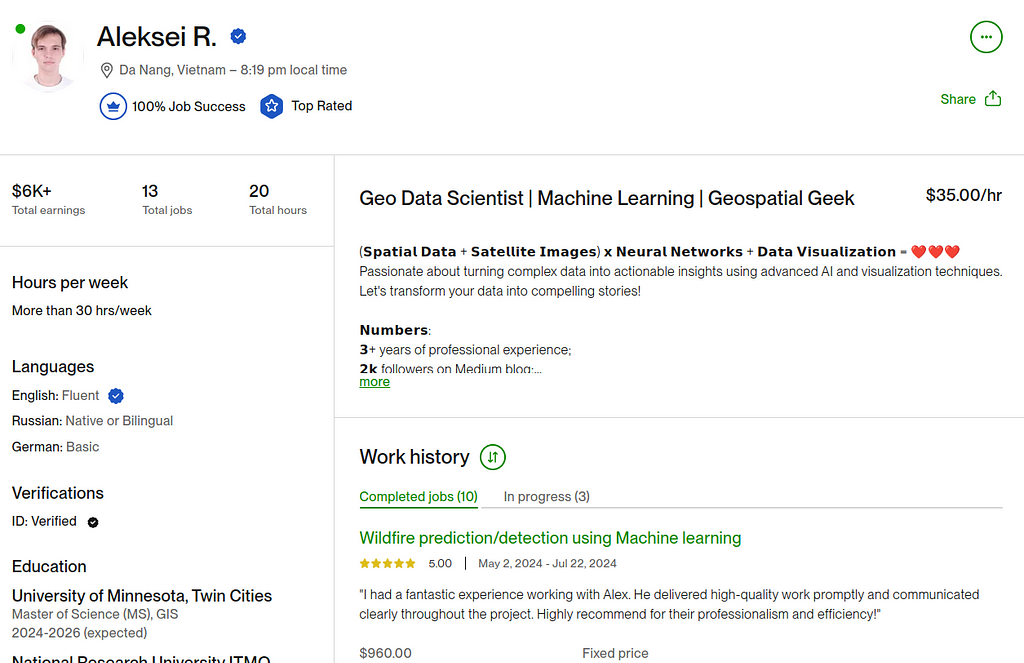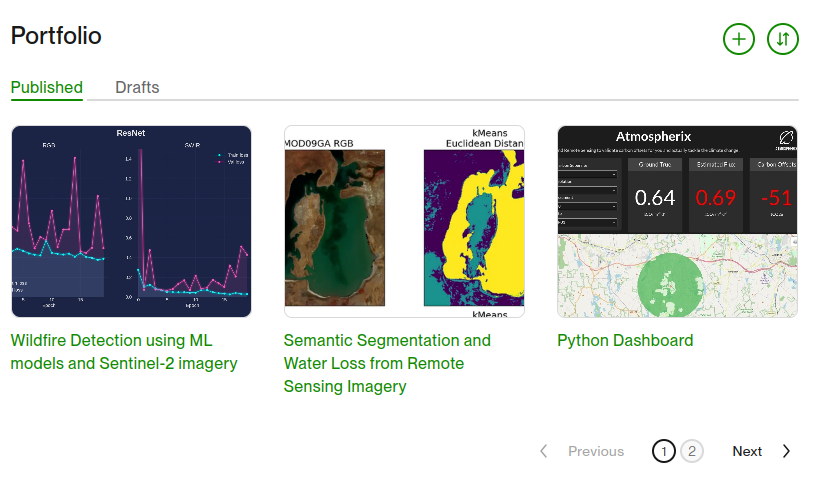My Freelance Experience as a Geo Data Scientist on UpWork after 10 Months
How to get clients, reviews and stable income

Around 10 months ago I decided that after several years of purely academic professional experience I want to try some freelancing/consulting. However, I found that my skill set was somewhat rare and weird.
On the one hand, my masters degree in Big Data and Machine Learning equipped me with a range of very helpful tools and knowledge of industrial data processing, modeling and analysis. However, I was extremely far from calling myslef an expert. Let’s say I had the skills of a junior data sceintist.
On the other hand, coming from the earth science domain, I knew how to work with geospatial data with a particular focus on remote sensing data (like satellite imagery for instance). Dumping a scenery from one of the NASA APIs, masking it, and performing some calculations was not a hard task for me at all. However, to call yourself an expert in this field you need to have a much deeper understanding of atmospheric optics, physics, and geoinformational systems (GIS).
So being eager to gain a taste of the world outside academia, I ended up trying to balance these two fields. Surprisingly, it turned out to be quite a good decision because this expertise is specific and niche.
There are tens of thousands of people worldwide who excel in machine learning developing the most crazy architectures, and others, who possess solid knowledge of remote sensing and satellite data processing. However, there are far fewer professionals who bridge these two fields. And I thought to myself: I might become one of them!

I strongly believe that the word niche is one the most important in this story. Firstly, I was scared of it. What if no one needs it? What if I don’t have projects, i.e. money? What if this expertise is too specific?
But in the end of the day, it was the key.
UpWork appeared to be one of the largest platforms for acquiring clients, with an impressive number of geo data science projects available. Recognizing the potential, I signed up, quickly filled out my profile, and showcased a pet project in my portfolio.
There were no false expectations: I knew that the first completed project with a testimonial is a must to start making any profit.
Of course, I began by submitting proposals for the most underpaid projects (ranging from $25 to $50 for everything). There are two significant issues associated with this kind of work:
- First, even if the task seems to be straightforward, you’ll likely spend at least an hour communicating with the client, collecting data, uploading results, and performing the analysis or modeling itself. At best, you’ll earn around $20 per hour, but more often, it’s closer to $10 or $12.
- Second, clients with low budgets tend to be the most demanding. On average, they introduce new requirements along the way and frequently request additional revisions. These clients typically prefer fixed-price projects, meaning that regardless of how much effort, time, or resources you invest, the budget remains the same — and it’s usually quite small (i.e. RIDICULOUSLY SMALL). That’s just how it is. I’d be glad to hear if you’ve had a different experience!
Of course, there are projects that are small by nature, for sure. I had a couple of experiences when I was asked to fix someone’s code, and those projects were very smooth and enjoyable for me (hopefully for the clients as well). For these minor corrections, I was compensated on an hourly basis, making the work just!
Nevertheless, those first two or three projects were crucial, as my profile was still mostly blank. No major client would trust a profile without established work. The key was to consistently apply for jobs.
After two months of steady effort, I began to experience a stable workload from various clients.
The most rewarding aspect was the knowledge I gained: from mastering basic communication, pitching, and negotiation skills to exploring new approaches, models, libraries, and tools in my field.
After five months of being a freelancer, I managed to secure a stable workload of 20 to 25 hours per week, which was perfect for me at that time. In total, my gross income on UpWork between January and August 2024 was $6,338, which I consider to be a very good number for a person with around 0 experience.
Unfortunately, recently I had to pause my UpWork journey, but I’m really determined to return in the future!
In the meanwhile, I’d like to share some tips and key takeaways from this experience with you. And hopefully, they will help you to succeed!
I. First of all, please narrow down as much as you can.
Do not call yourself just a Machine Learning Engineer, but Financial Data Scientist/Data Annotator/Medical Computer Vision Expert/LLM Architect, or Geo Data Scientist like in my case. You’ll be able to get a general data science project, but you’ll also a have a fixed niche.
Almost all the projects I had were in the geospatial field, but one of them was focused on the synthesis of the NLP datasets from scientific literature. I definitely had the competence to collect, structure, and describe this kind of data, despite officially being a geo person. By the way, the client gave 5/5 stars! So the niche will not limit you, don’t worry.
II. The lower the competition the better.
Sounds controversial, but please believe me. I saw hundreds of projects with more than 50 proposals from other freelancers. You don’t want this competition not because you’re not worth it, but because the client just won’t be able to adequately estimate the skills of all the professionals. They just want the work to be done.
So apply only when there are no more than 10 applications submitted, or apply, but avoid any false expectations about you working on this contract.


III. Don’t neglect what you write inside the proposals you submit.
Normally UpWork hides the name of the client, but if you check their testimonials, you might find that other freelancers mentioned the name of this person in their reviews, so please address clients by their names!
Add an external portfolio like GitHub/personal website or any other platform which can become an indicator of your skills. UpWork allows you to attach up to 3 projects from your UpWork portfolio, which often is not enough. So definitely share some links with the client to get familiar with other projects of yours more deeply. In my case, many clients referred to my blog on Medium as one of the key reasons to hire me. It’s a straightforward way to see my technical and communications skills.
Lastly, don’t center the proposal around your personality. I know you want to prove you’re the best for this project. But no one cares, sorry. The only thing the client cares about is the problem being solved. So focus on it. Show your care and passion to help. Treat the client like a doctor willing to heal a wound, not a businessman chasing another payday.
IV. Stay away from “re-sellers”.
This is the kind of clients who act like brokers or agents. They hunt for sweet projects on many different platforms, get the contract, and then go to UpWork to hire someone else for the lower price.
Why is it bad? Because they barely communicate with you and the client on the other side. They are not in the context of the project at all.
I was unfortunate enough to get this kind of a client for my first project. He ended up creating a group chat with me and the initial client asking me not to tell this person that I’m the one doing the job.
The solution is simple: check their previous projects. Normally, the agents have tons of reviews (not necessarily bad). But the titles of the projects are not connected at all. If this person is hiring people to do data analysis, satellite imagery processing, editing a video, solving math olympiad, and 3D design, it does look suspicious!
V. Use GPT to make your pet project shine. Anything you put in your portfolio on UpWork should have some story behind it. In the very beginning the only thing you have is a pet project or some assignment from a class. Leverage ChatGPT to create a compelling description of your work. Make it look like a real job with some impact and industry application.
With your first clients you’ll be able to add more and more, but from my experience, 4–5 examples of your work is enough.

Hopefully those four bullet points were informative and insightful. I wish I knew this stuff 10 month ago before starting this journey.
If you’re considering creating a new side hustle or leaving your 9/5 job to become a freelancer, UpWork might be a very good place to consider, at least for the first 1–1.5 years.
I wish you inspiring projects, interesting clients, and rapid professional growth. Give this article a few claps you liked it:)
===========================================
All my publications on Medium are free and open-access, that’s why I’d really appreciate if you followed me here!
P.s. I’m extremely passionate about (Geo)Data Science, ML/AI and Climate Change. So if you want to work together on some project pls contact me in LinkedIn and check out my website!
🛰️Follow for more🛰️
My Freelance Experience as a Geo Data Scientist on UpWork after 10 Months was originally published in Towards Data Science on Medium, where people are continuing the conversation by highlighting and responding to this story.
from Datascience in Towards Data Science on Medium https://ift.tt/RIJZFbr
via IFTTT




